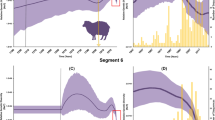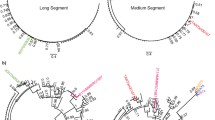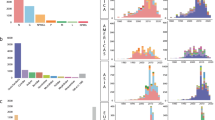Abstract
Bluetongue virus (BTV) is a midge-borne member of the genus Orbivirus that causes an eponymous debilitating livestock disease of great agricultural impact and which has expanded into Europe in recent decades. Reassortment among the ten segments comprising the double-stranded (ds) RNA genome of BTV has played an important role in generating the epidemic strains of this virus in Europe. In this study, we investigated the dynamics of BTV genome segment evolution utilizing time-structured data sets of complete sequences from four segments, totalling 290 sequences largely sampled from ruminant hosts. Our analysis revealed that BTV genome segments generally evolve under strong purifying selection and at substitution rates that are generally lower (mean rates of ~0.5–7 × 10−4 nucleotide substitutions per site, per year) than vector-borne positive-sense viruses with single-strand (ss) RNA genomes. These also represent the most robust estimates of the nucleotide substitution rate in a dsRNA virus generated to date. Additionally, we determined that patterns of geographic structure and times to most recent common ancestor differ substantially between each segment, including a relatively recent origin for the diversity of segment 10 within the past millennium. Together, these findings demonstrate the effect of reassortment to decouple the evolutionary dynamics of BTV genome segments.



Similar content being viewed by others
References
Anthony SJ, Maan N, Maan S, Sutton G, Attoui H, Mertens PPC (2009) Genetic and phylogenetic analysis of the non-structural proteins NS1, NS2 and NS3 of epizootic haemorrhagic disease virus (EHDV). Virus Res 145:211–219
Barratt-Boyes SM, MacLachlan NJ (1994) Dynamics of viral spread in bluetongue virus infectedcalves. Vet Microbiol 40:361–371
Batten CA, Maan S, Shaw AE, Maan NS, Mertens PP (2008) A European field strain of bluetongue virus derived from two parental vaccine strains by genome segment reassortment. Virus Res 137:56–63
Bonneau KR, Mullens BA, MacLachlan NJ (2001) Occurrence of genetic drift and founder effect during quasispecies evolution of the VP2 and NS3/NS3A genes of bluetongue virus upon passage between sheep, cattle, and Culicoides sonorensis. J Virol 75:8298–8305
Chare ER, Holmes EC (2004) Selection pressures in the capsid genes of plant RNA viruses reflect mode of transmission. J Gen Virol 85:3149–3157
Coffey LL, Vasilakis N, Brault AC, Powers AM, Tripet F, Weaver SC (2008) Arbovirus evolution in vivo is constrained by host alternation. Proc Natl Acad Sci USA 105:6970–6975
de Mattos CC, de Mattos CA, MacLachlan NJ, Giavedoni LD, Yilma T, Osburn BI (1996) Phylogenetic comparison of the S3 gene of United States prototype strains of bluetongue virus with that of field isolates from California. J Virol 70:5735–5739
Drummond AJ, Rambaut A (2007) BEAST: Bayesian evolutionary analysis by sampling trees. BMC Evol Biol 7:e214
Drummond AJ, Pybus OG, Rambaut A (2003) Inference of viral evolutionary rates from molecular sequences. Adv Parasitol 54:331–358
Drummond AJ, Rambaut A, Shapiro B, Pybus OG (2005) Bayesian coalescent inference of past population dynamics from molecular sequences. Mol Biol Evol 22:1185–1192
Drummond AJ, Ho SYW, Phillips MJ, Rambaut A (2006) Relaxed phylogenetics and dating with confidence. PloS Biol 4:699–710
Duffy S, Shackelton LA, Holmes EC (2008) Rates of evolutionary change in viruses: patterns and determinants. Nat Rev Genet 9:267–276
Edgar RC (2004) MUSCLE: multiple sequence alignment with high accuracy and high throughput. Nucleic Acids Res 32:1792–1797
Gould AR, Pritchard LI (1990) Relationships amongst bluetongue viruses revealed by comparisons of capsid and outer coat protein nucleotide sequences. Virus Res 17:31–52
Hanada K, Suzuki Y, Gojobori T (2004) A large variation in the rates of synonymous substitution for RNA viruses and its relationship to a diversity of viral infection and transmission modes. Mol Biol Evol 21:1074–1080
Heath L, van der Walt E, Varsani A, Martin DP (2006) Recombination patterns in aphthoviruses mirror those found in other picornaviruses. J Virol 80:11827–11832
Holmes EC (2009) The evolution and emergence of RNA viruses. Oxford University Press, Oxford
Jenkins GM, Rambaut A, Pybus OG, Holmes EC (2002) Rates of molecular evolution in RNA viruses: a quantitative phylogenetic analysis. J Mol Evol 2:156–165
Kowalik TF, Li JKK (1991) Bluetongue virus evolution: sequence analysis of the genomic S1 segments and major core protein VP7. Virol 181:749–755
Maan S, Maan NS, Samuel AR, Rao S, Attoui H, Mertens PP (2007) Analysis and phylogenetic comparisons of full-length VP2 genes of the 24 bluetongue virus serotypes. J Gen Virol 88:621–630
Maan S, Maan NS, Ross-Smith N, Batten CA, Shaw AE, Anthony SJ, Samuel AR, Darpel KE, Veronesi E, Oura CA, Singh KP, Nomikou K, Potgieter AC, Attoui H, van Rooij E, van Rijn P, De Clercq K, Vandenbussche F, Zientara S, Breard E, Sailleau C, Beer M, Hoffman B, Mellor PS, Mertens PPC (2008) Sequence analysis of bluetongue virus serotype 8 from the Netherlands 2006 and comparison to other European strains. Virol 377:308–318
MacLachlan NJ (1994) The pathogenesis and immunology of bluetongue virus infection of ruminants. Comp Immunol Microbiol Infect Dis 17:197–206
Martin DP, Posada D, Crandall KA, Williamson C (2005) A modified bootscan algorithm for automated identification of recombinant sequences and recombination breakpoints. AIDS Res Hum Retroviruses 21:98–102
Mellor PS, Wittmann EJ (2002) Bluetongue virus in the mediterranean basin 1998–2001. Vet J 164:20–37
Mellor PS, Carpenter S, Harrup L, Baylis M, Mertens PP (2008) Bluetongue in Europe and the Mediterranean Basin: history of occurrence prior to 2006. Prev Vet Med 87:4–20
Mertens PP, Pedley S, Cowley J, Burroughs JN, Corteyn AH, Jeggo MH, Jennings DM, Gorman BM (1989) Analysis of the roles of bluetongue virus outer capsid proteins VP2 and VP5 in determination of virus serotype. Virol 170:561–565
Mertens PP, Maan S, Samuel A, Attoui H (2005) Family Reoviridae. In: Fauquet CM, Mayo MA, Maniloff J, Desselberger U, Ball LA (eds) Virus taxonomy: Classification and nomenclature. Eighth report of the international committee on the taxonomy of viruses. Elsevier Academic Press, Oxford, pp 466–483
Nomikou K, Dovas CI, Maan S, Anthony SJ, Samuel AR, Papanastassopoulou M, Maan NS, Mangana O, Mertens PP (2009) Evolution and phylogenetic analysis of full-length VP3 genes of Eastern Mediterranean bluetongue virus isolates. PloS ONE 4:e6437
Oberst RD, Stott JL, Blanchard-Channell M, Osburn BI (1987) Genetic reassortment of bluetongue virus serotype 11 strains in the bovine. Vet Microbiol 15:11–18
Parker J, Rambaut A, Pybus OG (2008) Correlating viral phenotypes with phylogeny: accounting for phylogenetic uncertainty. Infect Genet Evol 8:239–246
Parra GI, Bok K, Martinez M, Gomez JA (2004) Evidence of rotavirus intragenic recombination between two sublineages of the same genotype. J Gen Virol 85:1713–1716
Pierce CM, Balasuriya UB, MacLachlan NJ (1998) Phylogenetic analysis of the S10 gene of field and laboratory strains of bluetongue virus from the United States. Virus Res 55:15–27
Pond SLK, Frost SDW (2005a) HyPhy: hypothesis testing using phylogenies. Bioinformatics 21:676–679
Pond SLK, Frost SDW (2005b) Datamonkey: rapid detection of selective pressure on individual sites of codon alignments. Bioinformatics 21:2531–2533
Pond SLK, Frost SDW (2005c) Not so different after all: a comparison of methods for detecting amino acid sites under selection. Mol Biol Evol 22:1208–1222
Posada D, Crandall KA (1998) MODELTEST: testing the model of DNA substitution. Bioinformatics 14:817–818
Posada D, Crandall KA (2001) Selecting the best-fit model of nucleotide substitution. Syst Biol 50:580–601
Pritchard LI, Gould AR, Wilson WC, Thompson L, Mertens PP, Wade-Evans AM (1995) Complete nucleotide sequence of RNA segment 3 of bluetongue virus serotype 2 (Ona-A). Phylogenetic analyses reveal the probable origin and relationship with other orbiviruses. Virus Res 35:247–261
Purse BV, Mellor PS, Rogers DJ, Samuel AR, Mertens PP, Baylis M (2005) Climate change and the recent emergence of bluetongue in Europe. Nat Rev Microbiol 3:171–181
Purse BV, Brown HE, Harrup L, Mertens PP, Rogers DJ (2008) Invasion of bluetongue and other orbivirus infections into Europe: the role of biological and climatic processes. Rev Sci Tech 27:427–442
Rambaut A (1996) Se-Al: sequence alignment editor. http://evolve.zoo.ox.ac.uk/
Ramig RF, Garrison C, Chen D, Bell-Robinson D (1989) Analysis of reassortment and superinfection during mixed infection of vero cells with bluetongue virus serotypes 10 and 17. J Gen Virol 70:2595–2603
Saegerman C, Bolkaerts B, Baricalla C, Raes M, Wiggers L, de Leeuw I, Vandenbuscche F, Zimmer J-Y, Haubruge E, Cassart D, Clercq KD, Kirschvink N The impact of naturally-occurring, trans-placental bluetongue virus serotype-8 infection on reproductive performance in sheep. Veterin J. doi:10.1016/j.tvjl.2009.11.012 (in press)
Saegerman C, Berkvens D, Mellor PS (2008) Bluetongue epidemiology in the European Union. Emerg Infect Dis 14:539–544
Schwartz-Cornil I, Mertens PP, Contreras V, Hemati B, Pascale F, Bréard E, Mellor PS, MacLachlan NJ, Zientara S (2008) Bluetongue virus: virology, pathogenesis and immunity. Vet Res 39:e46
Shapiro B, Rambaut A, Drummond AJ (2006) Choosing appropriate substitution models for the phylogenetic analysis of protein-coding sequences. Mol Biol Evol 23:7–9
Slatkin M, Maddison WP (1989) A cladistic measure of gene flow measured from phylogenies of alleles. Genet 123:603–613
Spreull J (1905) Malarial catarrhal fever (bluetongue) of sheep in South Africa. J Comp Pathol Ther 18:321–337
Stott JL, Blanchard-Channell M, Stott ML, Barratt-Boyes SM, Maclachlan NJ (1992) Bluetongue virus tropism for bovine lymphocyte sub-populations. In: Walton TE, Osburn BI (eds) Bluetongue African Horse Sickness and related orbiviruses. CRC Press, Boca Raton, pp 781–787
Swofford DL (2001) PAUP*. Phylogenetic Analysis Using Parsimony (*and Other Methods). Version 4. Sinauer Associates, Sunderland
Takamatsu H, Mellor PS, Mertens PP, Kirkham PA, Burroughs JN, Parkhouse RM (2003) A possible overwintering mechanism for bluetongue virus in the absence of the insect vector. J Gen Virol 84:227–235
Wang TH, Donaldson YK, Brettle RP, Bell JE, Simmonds P (2001) Identification of shared populations of human immunodeficiency virus type 1 infecting microglia and tissue macrophages outside the central nervous system. J Virol 75:11686–11699
Wilson A, Mellor P (2008) Bluetongue in Europe: vectors, epidemiology and climate change. Parasitol Res 103:S69–S77
Wilson A, Darpel K, Mellor PSS (2008) Where does bluetongue virus sleep in the winter? PLoS Biol 6:e210
Woelk CH, Holmes EC (2002) Reduced positive selection in vector-borne RNA viruses. Mol Biol Evol 19:2333–2336
Author information
Authors and Affiliations
Corresponding author
Electronic supplementary material
Below is the link to the electronic supplementary material.
Rights and permissions
About this article
Cite this article
Carpi, G., Holmes, E.C. & Kitchen, A. The Evolutionary Dynamics of Bluetongue Virus. J Mol Evol 70, 583–592 (2010). https://doi.org/10.1007/s00239-010-9354-y
Received:
Accepted:
Published:
Issue Date:
DOI: https://doi.org/10.1007/s00239-010-9354-y




